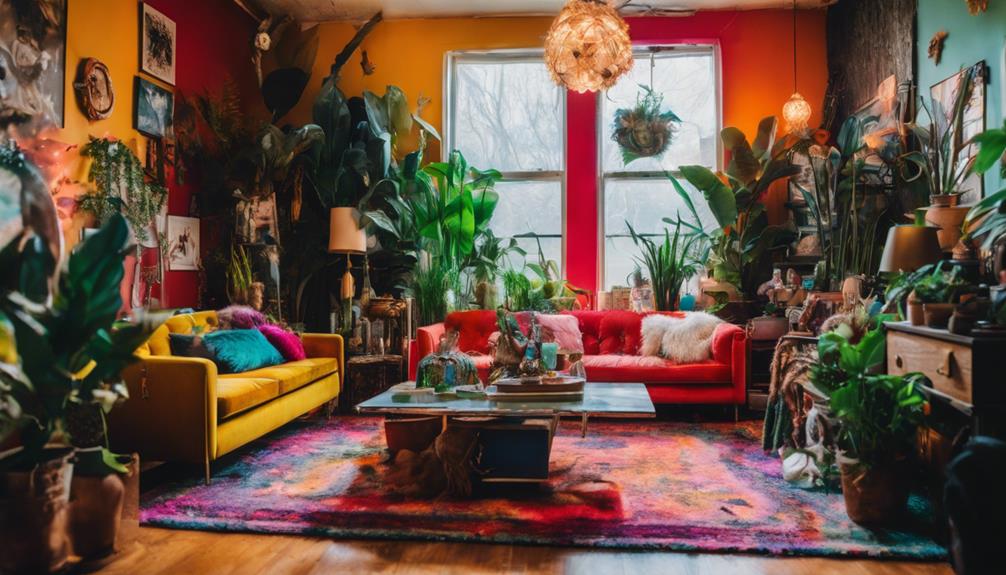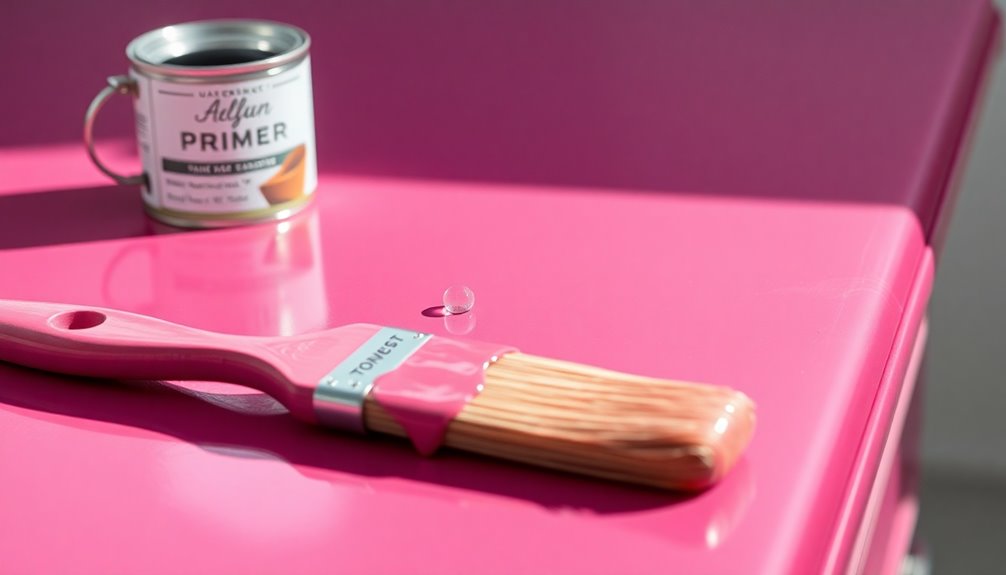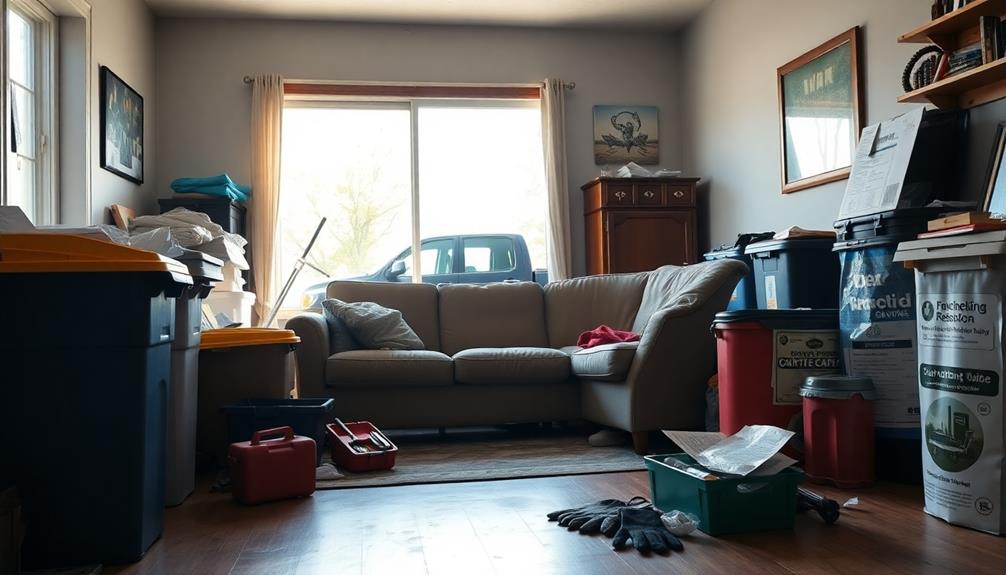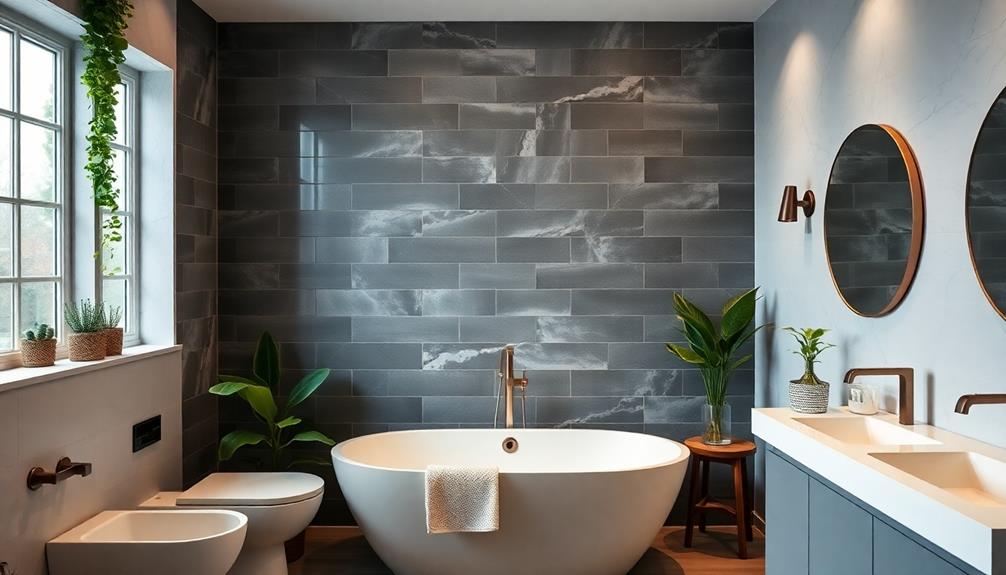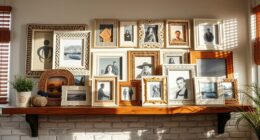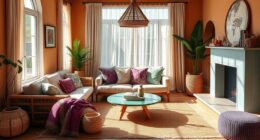Embracing unique room decor can completely transform your space into a vibrant reflection of your individual personality. You can experiment with bright colors, mixing vibrant palettes and incorporating unconventional materials like reclaimed wood or funky textiles. Textures are also important; layer different materials to create an inviting atmosphere. Consider eye-catching fixtures such as vintage steampunk tables or neon bar stools to spark conversations. Enhance your space with whimsical lighting, and don’t forget quirky decorative elements like vintage taxidermy or playful wall tapestries. If you want to learn more about how to bring it all together, there is more to explore!
Key Elements

When you're designing weird room decor, the color scheme, materials, and textures play a vital role in setting the tone.
Choosing bold colors and unconventional materials can transform a space into something truly unique.
You'll find that mixing and matching different textures adds depth and intrigue, making your decor even more compelling.
Color Scheme
A vibrant color palette featuring electric blues, radiant yellows, and fiery reds can instantly transform your weird room decor into a lively and engaging space. By stepping away from traditional monochrome schemes, you can create an atmosphere that bursts with energy and creativity.
Techniques like color blocking and ombre add visual interest, allowing you to play with patterns and colors that reflect your personal style. Mixing complementary colors among your decor items can create striking contrasts, making statement pieces or quirky accessories stand out. For instance, pairing sage green with bright hues not only surprises but also contributes to a relaxed yet vibrant ambiance.
Lighter wall tones alongside bold accent colors can create the illusion of a larger space while maintaining a fun and eclectic vibe. Don't be afraid to experiment! Unexpected combinations can define your weird room decor and make it uniquely yours.
Embrace the unusual by daring to mix and match colors in a way that surprises and delights. Your space should be a reflection of your personality, so let your color scheme do the talking!
Materials
Incorporating unusual materials like recycled metals, driftwood, and vibrant textiles instantly adds a whimsical touch to your weird room decor. These unique elements not only catch the eye but also infuse your space with personality and charm.
Think about using reclaimed wood for a coffee table or metallic accents for wall art—these statement pieces can become the focal points of your room.
You can also explore the beauty of bold colors and patterns in your materials. Geometric fabrics or metallic finishes create striking visual contrasts that draw attention and spark conversation. By mixing these unusual materials, you'll craft an environment that feels alive and inviting.
Don't shy away from upcycling old furniture or decor items; this approach promotes sustainability while adding character and history to your room. Embrace eclectic decor elements, like quirky rugs or innovative lighting fixtures made from unconventional materials.
These choices not only reflect your personal style but also serve as conversation starters, inviting guests to engage with your unique aesthetic.
Textures
Textures energize your space by creating a tactile rhythm that enhances the overall sensory experience. By incorporating a diverse range of materials, like plush faux fur, shiny metallic surfaces, and earthy jute rugs, you can cultivate a unique style that stands out. Mixing smooth, rough, shiny, and matte textures not only enhances visual interest but also adds depth to your decor, making your environment more engaging.
Layering different textures, such as crinkled leather with cool marble, evokes distinct feelings and contributes to a cozy, lived-in atmosphere. Quirky decor items featuring unexpected textures—like driftwood or recycled metal—infuse whimsy and individuality into your design. This playful approach to decor allows each element to contribute uniquely to the overall aesthetic of your space.
Embrace the opportunity to experiment with various textures; it's a fun way to express your personality and creativity. Remember, the right combination of textures can transform an ordinary room into an extraordinary experience, surprising anyone who steps inside.
Essential Fixtures and Furniture
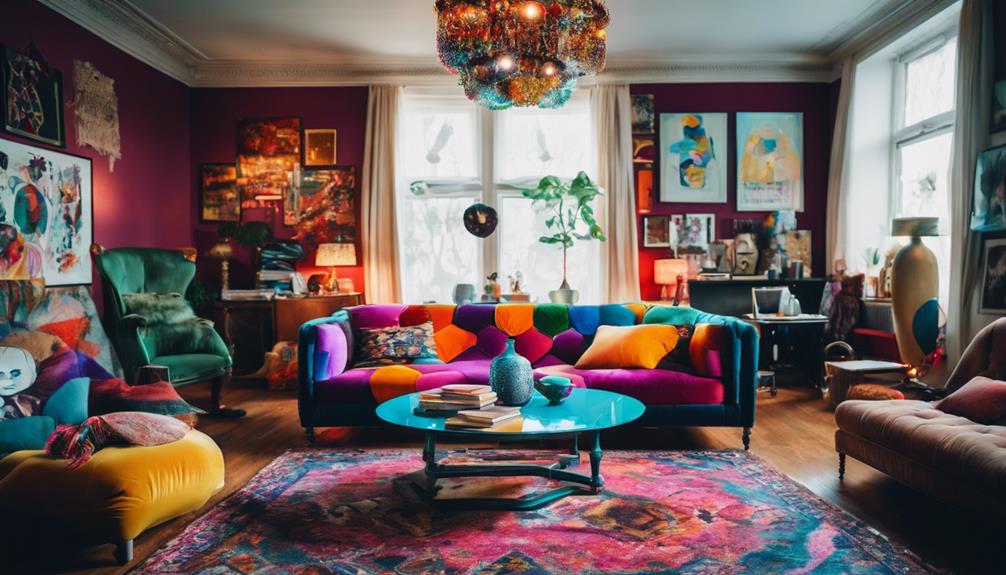
When it comes to essential fixtures and furniture for your weird room decor, think outside the box.
A vintage steampunk coffee table, retro neon bar stools, and a vintage record player stand can set the perfect tone for an eclectic space.
These pieces not only serve a purpose but also spark conversation and reflect your unique style.
Vintage Steampunk Coffee Table
A vintage steampunk coffee table adds a striking focal point to your room, blending intricate designs with functional elements that spark conversation. These tables often showcase a mix of reclaimed wood, metal gears, and glass, embodying the industrial aesthetic that defines steampunk style.
You'll find that their unique craftsmanship can transform your living space, making them impressive conversation starters. Look for features like hidden storage compartments or adjustable heights, which enhance practicality without sacrificing the quirky appeal you desire.
The combination of materials, such as wood, metal, and occasionally leather, creates a visually stimulating piece that adds depth and interest to your decor. Pairing your coffee table with other vintage items, like a vintage chest, can further elevate the eclectic vibe.
When selecting a vintage steampunk coffee table, consider the finish, size, and overall theme of your space. You want to guarantee it complements your unusual aesthetic while standing out as a statement piece.
Embrace the charm of steampunk design, and watch how your coffee table draws in guests, inviting them to admire its artistry and share in the experience.
Retro Neon Bar Stools
Retro neon bar stools often bring a burst of color and personality to your space, instantly elevating your decor with their playful designs. These vibrant stools are perfect for incorporating retro elements into your home, making a bold statement that captures attention.
With their eye-catching neon accents, they serve as both functional seating and statement pieces, sparking conversation among guests. You can find these stools in various materials, like chrome and leather, which not only enhance their visual appeal but also guarantee durability and comfort.
Plus, many retro neon bar stools are adjustable in height, giving you versatility for different settings—from home bars to kitchen counters. Pair them with funky lighting and colorful artwork to create a cohesive and lively atmosphere that's both inviting and fun.
Whether you're hosting friends or enjoying a quiet evening, these stools add a unique charm that's hard to resist. Embrace the unusual aesthetic that retro neon bar stools offer, and let your space shine with personality and flair! You'll love how they transform your decor into something truly memorable.
Vintage Record Player Stand
Showcasing your vinyl collection, a vintage record player stand adds both functionality and nostalgic charm to your living space. These unique furniture pieces not only serve as a dedicated spot for your turntable but also provide integrated storage for your records, promoting organization while enhancing your home decor.
You'll find vintage record player stands in various styles, from mid-century modern to retro and industrial designs. This versatility means you can easily incorporate one into your eclectic aesthetic, making it a standout feature in your room. The craftsmanship of these stands often reflects the artistry of past decades, adding character that modern furniture can't replicate.
Investing in a vintage record player stand is also an eco-friendly choice. By opting for repurposed materials, you're reducing waste while embracing a sustainable lifestyle.
Plus, the charm of these stands can spark conversations, making them ideal centerpieces for your living room or music corner. Celebrating your love for music and retro culture, a vintage record player stand is more than just furniture; it's a statement piece that transforms your space into a unique sanctuary.
Lighting Ideas
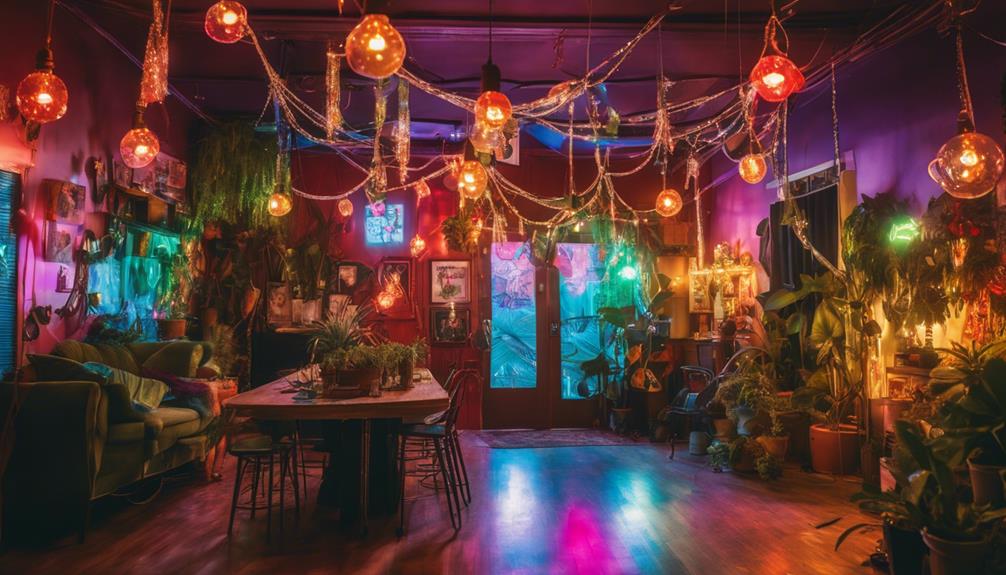
When it comes to lighting, you can really make your space stand out with options like neon tube wall sconces or colorful LED strip lights.
Vintage pendant light fixtures and hanging Edison bulb installations not only brighten your room but also add a unique character.
Let's explore these creative lighting ideas that'll transform your decor.
Neon Tube Wall Sconces
Neon tube wall sconces brighten up your space with vibrant colors, making them a perfect choice for modern and eclectic decor. These eye-catching fixtures instantly elevate your room's ambiance and serve as a striking focal point that draws attention. Available in various shapes and designs, you can easily find neon tube sconces that match your unique aesthetic preferences, allowing you to express your personality.
One of the best features of these sconces is their versatility. Many are dimmable, so you can adjust the brightness to create the right atmosphere for any occasion—whether you want bright and energetic lighting for a lively gathering or soft and relaxing illumination for a cozy night in.
Plus, they're energy-efficient, utilizing LED technology that not only reduces electricity costs but also lasts longer than traditional bulbs.
Colorful LED Strip Lights
Colorful LED strip lights transform any space into a vibrant haven, offering endless possibilities for personalized lighting design. You can easily install them along walls, ceilings, or even furniture, creating a dynamic ambiance that complements your unique style. With a variety of colors and brightness settings, these lights let you tailor your color scheme to fit any mood or occasion.
Using a remote or smartphone app, you can control the lighting effects, enabling you to switch between different themes effortlessly. Many LED strip lights come equipped with color-changing modes and music synchronization, enhancing the sensory experience that makes your room truly special.
Not only do these energy-efficient lights consume less power than traditional options, but they also add depth and excitement to your space. You can creatively highlight architectural features, artwork, or furniture, incorporating them as essential design elements.
Whether you're aiming for a cozy atmosphere or a lively party vibe, colorful LED strip lights are an excellent choice for embracing unusual aesthetics in your decor. They're sure to surprise and delight anyone who steps into your transformed space!
Vintage Pendant Light Fixtures
Adding vintage pendant light fixtures can enhance your room's character, providing a unique focal point that perfectly complements the modern flair of your colorful LED strip lights. These fixtures often feature stunning designs crafted from materials like glass, metal, or ceramic, showcasing styles that range from mid-century modern to industrial chic.
When you incorporate vintage pendant lights, you evoke a sense of nostalgia while creating a warm and inviting atmosphere. They're perfect for spaces like dining areas, kitchens, or living rooms, where they can add charm and personality. Plus, you can often find budget-friendly options at thrift stores or online marketplaces, making it easy to add character without breaking the bank.
Pairing these vintage pendant light fixtures with contemporary elements creates a striking contrast, highlighting the beautiful blend of old and new aesthetics in your decor. The result is an eclectic style that surprises and delights anyone who enters your space.
Don't underestimate the impact of well-placed vintage lighting—it's an effortless way to elevate your room's vibe while showcasing your unique taste.
Hanging Edison Bulb Installations
Hanging Edison bulb installations instantly transform your space, creating a vintage yet modern ambiance that invites warmth and charm. These unique light fixtures are perfect for adding character to eclectic rooms, as their warm glow enhances any environment.
You can arrange Edison bulbs in various formations—clusters, linear patterns, or even staggered heights—allowing for creative expression and personalization in your design.
Consider incorporating dimmable Edison bulbs to enhance versatility; this feature lets you adjust the lighting levels to match different moods or occasions. Plus, with a variety of shapes and sizes available, mixing and matching these bulbs can create a distinctive lighting display that complements your decor.
For a truly artistic flair, hang Edison bulbs in unconventional settings, like inside geometric frames or suspended from the ceiling. This approach not only draws attention but also elevates the overall aesthetic of your space.
Decorative Elements
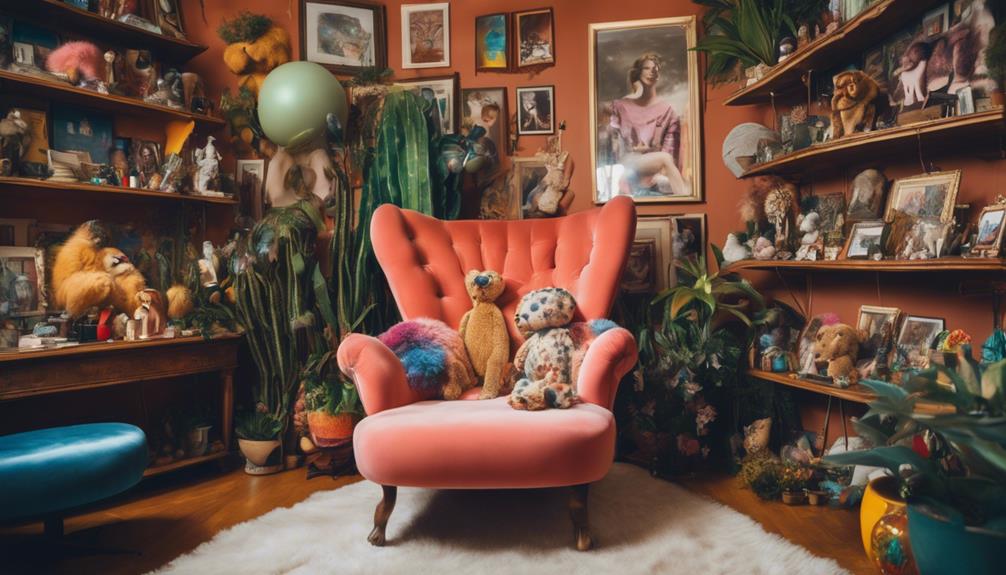
When it comes to decorative elements, you can really make your space pop with vintage taxidermy wall art, whimsical wall-mounted planters, or funky wall tapestries.
These unique additions not only serve as striking focal points but also reflect your personal style.
Let's explore how each of these options can transform your room into a conversation-worthy haven.
Vintage Taxidermy Wall Art
Vintage taxidermy wall art creates a striking focal point in your home, showcasing the beauty of nature while sparking intriguing conversations. This unique and eclectic decor element often features a variety of animals, from small birds to larger mammals, preserved in lifelike poses. By incorporating vintage taxidermy, you not only add an eye-catching piece but also evoke a sense of nostalgia and adventure.
When displayed thoughtfully, vintage taxidermy can enhance various design styles, whether you prefer rustic, eclectic, or even modern aesthetics. It connects viewers to the past, exploring themes of nature and wildlife, which can deeply resonate with your guests. Collectors and enthusiasts frequently seek out these distinctive pieces at antique shops, flea markets, or online auctions, ensuring that each item has its own story and charm.
In your quest for unique decor, vintage taxidermy wall art stands out as an excellent choice. It allows you to curate a personalized environment that reflects your interests and values. So, if you're ready to embrace the unusual, consider adding a piece of vintage taxidermy to your wall—it might just become the centerpiece of your home.
Whimsical Wall-Mounted Planters
Whimsical wall-mounted planters transform your space by turning plants into eye-catching decor that saves valuable floor space. These playful planters come in a variety of shapes and designs, from quirky animal figures to abstract geometric forms, making it easy for you to express your personality. By incorporating these unique pieces, you not only enhance your room's vertical aesthetic but also improve indoor air quality with a touch of greenery.
You can easily customize these whimsical wall-mounted planters with paint or embellishments, allowing you to match them to your room's color scheme. This versatility makes them an ideal addition to eclectic decor. Hanging plants in these fun planters creates a dynamic visual effect that draws the eye and encourages creativity.
As guests admire your unusual decor choices, these planters become conversation starters, showcasing your distinctive style. By inviting nature into your home in such a charming way, you create a lively atmosphere that surprises and delights everyone who enters.
Funky Wall Tapestry
Funky wall tapestries add a splash of color and personality to your space, serving as bold focal points that invite conversation and creativity. With an array of designs—like abstract patterns, vibrant colors, and whimsical motifs—these decorative elements allow you to express your unique style and taste.
Not only do funky wall tapestries brighten up your walls, but they also offer a practical solution for covering large spaces without the commitment of paint or wallpaper. They create a cozy atmosphere while adding texture, enhancing the overall sensory experience in your room. Imagine running your fingers over the fabric while admiring the art; it's a feast for the senses!
One of the best aspects of these tapestries is their versatility. You can easily swap them out seasonally or whenever your decor evolves, ensuring your space remains dynamic and eclectic.
Whether you want to make a bold statement or add a subtle pop of color, funky wall tapestries can help transform your environment into something truly unique. So, why not embrace this unusual aesthetic and let your walls speak volumes?
Flooring
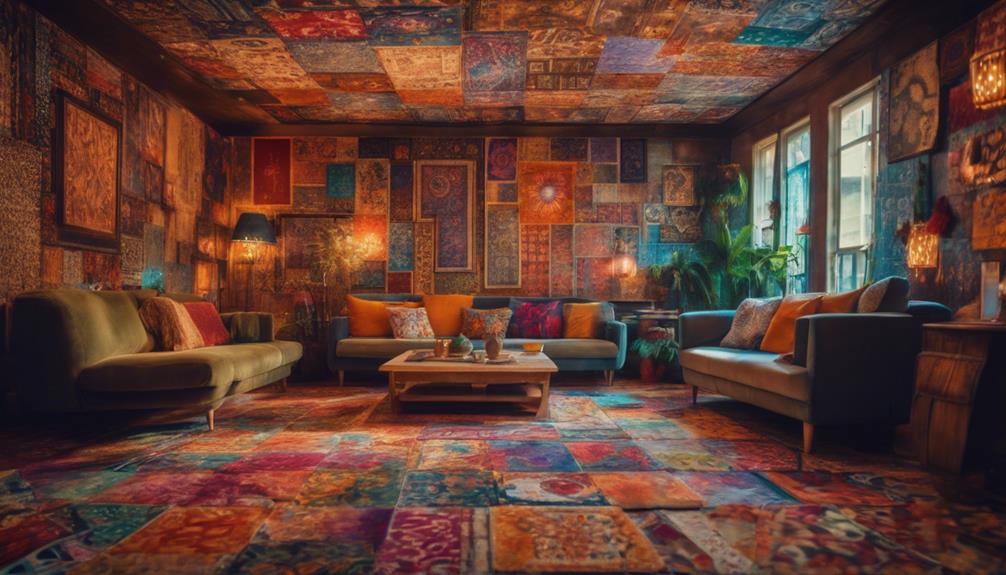
When it comes to flooring, don't shy away from unique options like reclaimed wood planks, colorful mosaic tiles, or brightly painted concrete.
These choices can transform your space, giving it character and charm.
Reclaimed Wood Plank Flooring
Reclaimed wood plank flooring brings a unique blend of rustic charm and sustainability to your space, as it repurposes wood that would otherwise be discarded. By choosing reclaimed wood, you not only enhance your home design but also take a step toward eco-friendliness. Each plank often carries a history, sourced from old barns or factories, providing diverse colors and textures that can transform your floors into a conversation starter.
One of the biggest advantages of reclaimed wood is its durability. Having been seasoned over time, it's less likely to warp or shrink, ensuring that your flooring lasts. Plus, installation of reclaimed wood reduces the need for new lumber, lowering the carbon footprint associated with deforestation.
While the cost can vary considerably—from $5 to $15 per square foot—it's a worthwhile investment for unique home decor. The character and individuality that reclaimed wood brings to your space can't be matched by conventional flooring options.
Colorful Mosaic Tile Flooring
Colorful mosaic tile flooring transforms any space with its vibrant patterns and endless design possibilities. You can create intricate designs that reflect your personality, making your home truly unique. This flooring option is available in different styles, allowing you to mix and match colors and textures to suit your aesthetic.
Whether you prefer the sleek look of glass or the rustic charm of natural stone, colorful mosaic tiles can elevate any room. Not only is this type of flooring visually stunning, but it's also durable and easy to maintain, perfect for high-traffic areas like kitchens or entryways.
Plus, you'll find colorful mosaic tiles in commercial spaces, such as restaurants and hotels, where they contribute to a lively and inviting atmosphere. While the installation of mosaic tile flooring can be complex, requiring professional expertise for precise alignment and intricate designs, it's worth the investment.
With the right installation, you'll enjoy a standout look that's both functional and stylish. Embrace the unusual aesthetic of colorful mosaic tile flooring, and surprise everyone with your bold design choices!
Brightly Painted Concrete Flooring
Brightly painted concrete flooring transforms dull spaces into vibrant canvases, allowing you to express your creativity with bold colors and unique patterns. This durable and low-maintenance flooring option is perfect for high-traffic areas, ensuring it withstands daily wear while still looking stunning. Non-toxic, high-quality concrete paint can elevate your space, turning an ordinary floor into an eye-catching focal point.
With brightly painted concrete flooring, you can explore endless design possibilities. From ombre effects to geometric shapes, the colors bring life to your home, reflecting your personal style. Textured finishes can add depth and dimension, enhancing both aesthetics and safety. This is especially important if you have children or pets, as slip resistance becomes essential.
Pair your colorful concrete floors with light-colored walls and strategic lighting, and you'll create an illusion of spaciousness and vibrancy. The versatility of painted concrete allows you to experiment and change designs as you wish, making it a dynamic choice for any room.
Conclusion
Embracing weird room decor is all about showcasing your unique personality and sparking conversation.
By thoughtfully selecting key elements, essential fixtures, and lighting, you'll create a space that surprises and delights.
Don't shy away from mixing decorative elements and opting for unconventional flooring—these choices reflect your individuality.
So, go ahead and let your creativity flow; your home should be a true reflection of you, inviting everyone to experience your extraordinary aesthetic.
